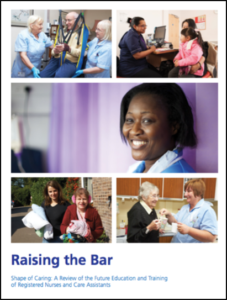Dr David Barrett, Director of Pre-Registration Nurse Education, Faculty of Health and Social Care, University of Hull
One of the perennial issues faced by nurse education and the nursing workforce is the formalisation of different categories of Registered Nurse. Whether called ‘fields’, ‘branches’ or ‘specialties’, there is continual discussion about what constitutes a standalone area of nursing and at which point in a nurse’s career specialisation should take place.
Discussion of this issue is particularly lively within the UK. Currently, there are four fields of nursing – Adult, Children, Learning Disabilities and Mental Health – with student nurses selecting their chosen field at the time of application to University, and then completing a degree (or higher) level programme of study focused on that field (albeit with some shared elements across fields).
However, this structure is under review and likely to change. The publication of ‘Raising the Bar’ – a review of nurse education in England – challenged the current model. The review suggested that current system of a three-year, field-specific programme of study did not produce flexible practitioners with the transferable skills necessary to work with patients and clients in a range of settings (Willis, 2015). The review proposed a more generic model, specifically suggesting that students complete two-year ‘whole-person’ education, before specialising in the final year of their programme and first year post-registration.

Since the publication of Raising the Bar, concerns have been raised about this proposed, more generic model. There have been passionate and well-argued defences of existing fields, such as Mental Health (McKeown & White, 2015) and Learning Disabilities (McClimens & Burns, 2016). A previous Evidence-Based Nursing blog and Twitter chat has also explored the specific implications for children’s nursing (https://stg-blogs.bmj.com/ebn/2015/05/17/shape-of-caring-review-impact-for-childrens-nursing-education/). These discussions highlight the need to endow student nurses with the specialist skills and knowledge required to care for their client groups, and argue that a more generic educational approach may lead to dilution of those skills.
There is, of course, no question that nurses caring for specific client groups need to develop a specific set of knowledge and skills to supplement their core nursing competences. This is applicable not just to those areas of care with existing fields, but also sub-specialities such as palliative care or primary care nursing. The issue then is not whether nurses need to specialise, but at what stage? Should student nurses make a choice of specialism – a decision that will dictate the course of their entire career – when they enter University, or would this decision be better informed if made further into a programme of study? Is the ideal model one of a generic nurse workforce that specialises only when working in a particular area following registration?
With complex issues such as this, it is often useful to be guided by practice globally. Unfortunately, it is difficult to learn much about specialisation in nursing at an international level, because practice is so disparate. Though there are some countries that operate a system of entry-level specialism similar to the UK, others adopt a completely generic model within pre-registration education (including some that even have generic pre-registration preparation of nurses and midwives) (Nichols et al, 2011)
In parallel with discussion of when specialisation takes place, there is also debate on how many fields of nursing there need to be. Raising the bar advocates the development of an additional field in community care, but there is also support within the nursing community for a pre-registration specialism in care of older people. The number and foci of specialist fields will always be a matter of debate and will often change according the needs of the population (for example, there was still a specific place on the UK nursing register for Fever Nurses until the mid-1960s). However, whilst the idea of new fields may be superficially attractive for those working in those areas, care must be taken not to try to fragment the nursing community to an extent where there is a danger of ‘silo’ working and a loss of a core identity.
David Barrett (@barrett1972) – Associate Editor of Evidence-Based Nursing – will be leading a Twitter chat on Wednesday 16th November (8pm-9pm GMT) that explores some of these issues. The specific questions will be:
- What are the main strengths and weaknesses of a field-based model of nursing?
- What models of nurse education and specialisation are there internationally? What lessons can they teach the UK?
- Assuming that a field-based model remains, what should the fields be?
- What is the best time for a nurse to specialise – on entry to education, at some stage during their programme of study, or post-registration?
Participating in the Twitter Chat requires a Twitter account; if you do not already have one you can create an account at www.twitter.com. Once you have an account, contributing is straightforward:
Go to your Twitter account
- Follow the discussion by searching for #ebnjc once linked to the discussion, click “all tweets” to keep up-to-date with recent tweets
- Add the EBN chat hash tag (#ebnjc) to your tweets to join in, this allows everyone taking part to view your contribution
References
McClimens A, Burns S (2016) Looking after people with learning disabilities part three: who will care? Learning Disability Practice 19(3): 28-32
McKeown M, White J The future of mental health nursing: are we barking up the wrong tree? Journal of Psychiatric and Mental Health Nursing, 22: 724–730
Nichols BL, Davis CR, Richardson DR (2011) International models of nursing. In: Committee on the Robert Wood Johnson Foundation Initiative on the Future of Nursing, at the Institute of Medicine. The future of nursing: Leading change, advancing health. Washington D.C, National Academies Press. 565-639. Available at: https://www.ncbi.nlm.nih.gov/books/NBK209879/#top [4th November 2016]
Willis T (2015) Raising the Bar. Shape of Caring: A Review of the Future Education and Training of Registered Nurses and Care Assistants Available at https://www.hee.nhs.uk/sites/default/files/documents/2348-Shape-of-caring-review-FINAL.pdf [6th November 2016]